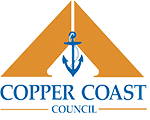Bees
Bees play a vital part in the pollinating of our native plants, gardens and vegetable patches. Approximately 80% of the food we eat relies on pollination in the process of growing and farming that food (eg the Copper Coasts largest industry being farming).

Native bees are the seemingly mysterious creatures that can make our tomatoes taste better, help pollinate our veggie gardens and live a very different lifestyle to honey bees. They are also important pollinators for many of our native plant species.There are at least 200 different kinds of native bees in South Australia and more than 1650 in Australia and about 20,000 species worldwide – and that number is growing as more species are identified.
With the onset of the warmer weather you may have noticed your garden becoming a buzzing hive of activity, with bees resting on your shrubs and trees and flowers as they wait for their scouts to map out a journey from their hives to their new nesting site.
On occasions there will be an increase in the movement of bees and bees may swarm into an undesired location requiring relocation. During this time, unfortunately, bees can build nests/hives in trees in your yard, or worse in the wall cavities and ceiling voids, or other nooks and crannies around the home.
During the warmer weather, bees may form a colony outside of the hive (swarming). This is their way of trying to get cool or establishing a colony and can for some people be quite concerning due to their size and the amount of bees present. Generally during this state, the bee colony is not aggressive as they are trying to protect the queen.
This not only increases the risk of being stung, but also of attracting other pests such as carpet beetles, wax moths, meal moths and other scavenging insects such as cockroaches, to your home.
Bee Swarm Relocation - Council Property
Council will relocate bees from Council land if it has been identified that the bees are causing a risk to public health and safety. Please call our Customer Service Team on (08) 8828 1200 to report a bee swarm that is causing a nuisance or is a public health and safety risk in your area and they will arrange for its relocation as soon as possible.
Remember that we need bees for our environment and food production and swarm relocation rather than destruction (where possible) is the choice that is good for all of us.
Bee Swam Relocation - Private Property
Council does not provide a service to relocate bees from private property and it is recommended that you do not attempt to remove a bee colony yourself as this is a specialised task. Instead, contact one of the many organisations and individuals that are pleased to assist you, and help the bees find a more suitable place to make their home.
Who can I contact to remove a swarm of bees?
The South Australia’s Beekeepers Society provides a list of people and contact phone numbers who can remove and relocate bees for a fee: http://www.bees.org.au/swarms/
Adelaide Bee Sanctuary on 0412 967 991 or on their website: www.adelaidebeesanctuary.com.au
Searching our local business directory by clicking here (keyword bees)
Alternatively, the following link will take you to an website where you can report a swarm of bees and a find local apiarist: http://www.swarmpatrol.com/
Pest controller (ie Hamiltons or Laidlaws in our area)
Bee-keeping
Under the Livestock Act 1997, any person who keeps honeybees must register as a bee-keeper every twelve (12) months.
You must register regardless of the:
- number of hives
- purpose for keeping honeybees (ie. You must register even if only keeping one hive in the backyard, for interest)
- type of hives (including: observation hives, nucleus hives, Top bar hives, Warre hives, and Flow hives).
Registration fees and hive contributions are based on the number of hives you keep.
All hives must be branded with a three (3) letter hive identification code issued when you first register.
The hive identification code must:
- be placed in the centre of an exposed vertical face of the hive - where the face of the hive has previously been marked with a code, any subsequent code allocated to the hive must be marked on the same vertical face, the first being placed in the top left hand corner of that face, and each subsequently allocated code being placed in the next corner proceeding clockwise
- be burned, stencilled, embossed, carved or etched onto the face of the hive, or inscribed on a metal plate secured to the face of the hive
- have each character of the code at least 30 millimetres in height.
Further information regarding bee-keeping can be located at:
- Biosecurity SA has a large amount of information, including the new Recreational Beekeeping – A guide to beekeeping in South Australia can be found here.
- Beekeepers' Society of SA.
Should you have any concerns regarding someone who has hives near you, contact the Council office on (08) 88281 200.

